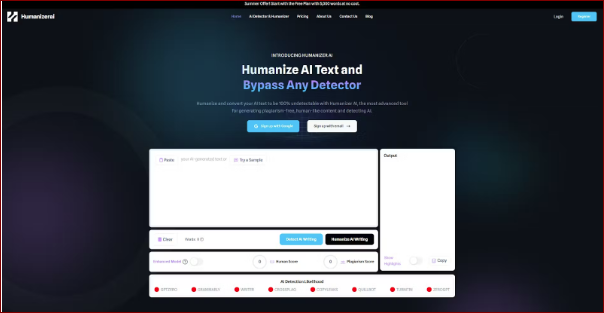Lots of people use AI to write now. Students, bloggers, small business owners, everyone leans on it to save time. But the copy that comes out of these tools often feels a little off. It can read like a neat machine tried to speak like a person: correct, but flat. Your writing should sound like it was written by a human being to make someone want to read and care about what you write.
Humanising AI is to make that neat, slightly less empty sort of text, and provide it with a live voice. That voice is short of choices and perfection, has unambiguous ideas, and a character. Either you can learn how to do this yourself, or you can always use an AI humanizer to hasten things along. Whichever way, the task is easy: to make the words feel alive.
Why AI writing often sounds flat
AI tools stitch together phrases by patterns. That gets you grammar and structure, but not warmth. Common signs a piece was written by a machine are long, formal words where a plain word would do, sentences that echo the same rhythm over and over, and no tiny personal notes. Readers sense that something is missing even if they can’t name it.
Think of a time you read a message that felt distant — maybe it had precise facts but no emotion. That’s the gap we fix when we humanize text.
What real, human writing looks like
Human writing feels like a friend talking. It uses simple words, mixes short and long lines, and drops in small, real details you wouldn’t invent in a template. People write with tiny quirks: a thought, a quick aside, a question. That’s the flavor that makes readers stay.
You do not have to select a character and project it as a costume. And what do you do, but just add a couple of pounds of honesty, a few inches of memory, an opinion, an inch or so, a couple of ounces of opinion, an opinion, an opinion, and then a couple of guys that say, Oh, I tried this, or, I tried this. The lived-in feel to the page is provided by those.
Easy steps to make AI text sound human
Start by reading the text out loud. If you trip, change it. Replace fancy words with everyday words. Break long sentences into two. Add one tiny personal sentence — “When I tried this, I noticed…” — and vary sentence lengths for rhythm. These edits take little time but change the whole tone.

Or, if you are more of the tool type of person, much of that is automatically done by an AI humanizer. You paste a paragraph, it straightens phrasing, changes the clumsy word to the plain, and drags the tone toward actual conversation. Use the tool Humanize AI to quickly rewrite it, and read through and adjust one or two lines, to make the voice your own.
Small edits that make a big difference
An active sentence of a few words will rouse an indifferent paragraph. One specific detail, the very store, the very day it rained, the very coffee you dropped–has more weight than three blanket adjectives. Where they are applicable, use contraction; a page is casual and friendly. To get the reader moving on, ask one short question at the end of the paragraph. These are all small, but combined, they switch the feeling of a piece being a robotic brochure to one of a real person talking.
A simple routine that works
If you use AI to draft, follow this easy routine: get a clear first draft, run it through an AI humanizer or the humanize AI tool, then read it out loud and add one or two personal lines. Finally, check for rhythm and shorten where needed. This three-step flow — draft, humanize, human-edit — saves time and keeps your voice.
One writer I know uses this on every blog post. They tell AI to write a rough draft, then they “humanize” the text and add one personal sentence near the top. Their posts read faster and get more comments than they did before.
Common mistakes to avoid
Don’t try to sound like someone else. Copying a trendy voice kills authenticity. Also, don’t over-edit until the text becomes strange and forced; tiny imperfections are what remind readers you’re human. And don’t rely only on tools — use them to speed up the job, then add a personal polish.
Why the phrase “humanize AI” matters
If you link to a tool or guide about making machine text read like a person, use humanize AI as the anchor text. It tells readers exactly what to expect and helps your content rank for that phrase. You can link to a trusted resource like this: humanize AI. Using the same anchor in sensible spots makes the page clearer for both people and search engines.
Small, real details are what turn a neat AI draft into something people want to read. For example, instead of “Many people enjoy coffee,” say “I spill my first cup every morning and still love it.” That tiny personal line makes a paragraph feel lived-in. Try turning one bland paragraph into a short story or memory. Add the one detail only you could give.
When you run that version through a tool or service like Humanize AI, the result keeps the detail and smooths the flow so it reads even better. Good AI humanizer tools won’t remove your voice; they’ll polish it. The goal is not to fake personality — it’s to highlight real lines that belong to you. Little moves like this change the whole piece from “informational” to “human,” which is the heart of any AI-to-human approach.
Quick edits you can do in five minutes
If you’re short on time, pick a paragraph and make five quick changes: shorten one long sentence, swap one fancy word for a plain one, add one small personal line, change passive voice to active, and end with a question. That’s it. These tiny edits take minutes, but they punch up the rhythm and make the text feel like a real conversation.
If you want a faster route, paste the same paragraph into a humanize AI tool and then do the five edits on the result. A good AI humanizer will give you options, but your quick human tweaks make it yours. This mix tool, plus a few human touches, is the most practical AI-to-human method for busy writers.
How to keep your voice while using tools
Using a tool doesn’t mean losing your voice. Treat the tool as a first pass. Ask it to make the text sound more natural, then read the output and keep anything that sounds like you. Add one true line, a memory, a small opinion, a brief example, and don’t hide it. If the tool tries to standardize that line, restore it.
Over time, you’ll learn which edits the tool handles well and which need your touch. This “tool then tweak” rhythm is exactly how AI humanizer tools should fit into your work. When you do this regularly, you’ll turn AI drafts into writing that feels personal and reliable, a clean AI-to-human pipeline that keeps you in control.
Conclusion
AI will keep assisting people to write more quickly. That’s fine. The real art is taking on crap drafts for real words. No matter if you do it yourself or use an AI humanizer, on simple words, random sentences, and one or two personal touches. See AI like someone is handing you a rough suit, tailor it so it fits is your job.
If one little thing you can do today is: pick one sentence, read it out loud, and rewrite one sentence to include an actual detail. One little edit and that whole paragraph feels more human. Making AI into writing that’s about people, not beating the tool. That’s what is the idea behind an AI-to-human method.
DISCLAIMER – “Views Expressed Disclaimer: The information provided in this content is for general informational purposes only and does not constitute financial, investment, legal, tax or health advice. Any opinions expressed are those of the author and do not necessarily reflect official position of any other author, agency, organization, employer or company, including NEO CYMED PUBLISHING LIMITED, which is the publishing company performing under the name Cyprus-Mail…more
You should not rely on the information as a substitute for professional advice tailored to your specific situation.







Click here to change your cookie preferences